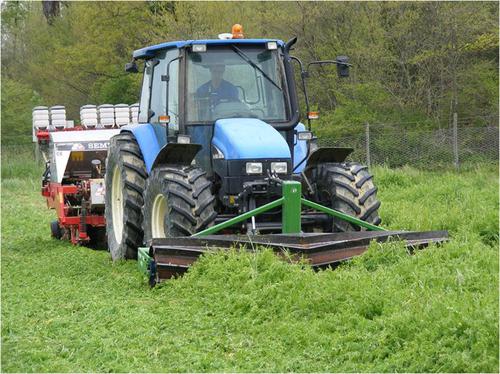Agronomy for Sustainable Development ( IF 6.4 ) Pub Date : 2022-08-25 , DOI: 10.1007/s13593-022-00815-2 Daniele Antichi , Stefano Carlesi , Marco Mazzoncini , Paolo Bàrberi

|
No-till cropping systems with cover crops can improve soil health, but often rely on glyphosate, which is a contentious herbicide. In this study, we investigated whether a system based on the direct sowing of sunflower (Helianthus annuus) in the dead mulch of a roller-crimped hairy vetch (Vicia villosa) could be competitive with a system where glyphosate is also sprayed to terminate the cover crop and to control weeds. We hypothesized that optimum timing of roller-crimping would be key to eliminate glyphosate requirements while maintaining sunflower performance. In a 3-year on-farm experiment, we compared three vetch termination stages (early: pre-flowering; Intermediate: beginning of flowering; late: 70% flowering) and three glyphosate rates (Nil, half and full, i.e. 1440 g of active ingredient per hectare). Vetch biomass increased progressively from early to late termination stages, and ranged between 414 and 658 g m−2. Higher vetch biomass was correlated with lower weed biomass. Treatments had inconsistent effects on weed diversity and composition, largely determined by the interactions between treatments and seasonal (different years) or local factors (different fields). Glyphosate-based treatments seemed to select for aggressive weed species, but no clear species filtering effect based on ecological or functional traits was detected. Shannon H’ was positively correlated with sunflower grain yield below a weed dry biomass threshold of 150 g m−2. Crop yield with early termination stage was a failure without glyphosate application. However, crop yield with late vetch termination was acceptable, being at par or 15% higher (mean of first and second years) in no-glyphosate compared with glyphosate-based treatments. Crop gross margins showed the same trend (+33% for no-glyphosate compared with glyphosate-based treatments). This study, for the first time, shows that targeted timing of roller-crimped hairy vetch in no-till sunflower can result in equal agronomic and economic performances as addition of glyphosate.
中文翻译:

使用滚筒压接机有针对性地终止多毛紫云英覆盖作物可以消除免耕向日葵中的草甘膦需求
覆盖作物的免耕种植系统可以改善土壤健康,但通常依赖草甘膦,这是一种有争议的除草剂。在这项研究中,我们调查了一种基于向日葵 ( Helianthus annuus ) 直接播种的系统是否适用于卷曲毛紫云英 ( Vicia villosa ) 的枯死覆盖物。) 可以与同时喷洒草甘膦以终止覆盖作物和控制杂草的系统竞争。我们假设辊压接的最佳时间是消除草甘膦需求同时保持向日葵性能的关键。在为期 3 年的农场实验中,我们比较了三个紫云英终止阶段(早期:开花前;中期:开花开始;晚期:70% 开花)和三种草甘膦率(零、半和全,即 1440 克每公顷活性成分)。野豌豆生物量从早期终止阶段到晚期终止阶段逐渐增加,范围在 414 和 658 gm -2之间. 较高的野豌豆生物量与较低的杂草生物量相关。处理对杂草多样性和组成的影响不一致,很大程度上取决于处理与季节性(不同年份)或当地因素(不同田地)之间的相互作用。基于草甘膦的处理似乎选择了侵略性杂草物种,但没有检测到基于生态或功能特征的明显物种过滤效果。香农 H' 与低于 150 gm -2的杂草干生物量阈值的向日葵籽粒产量呈正相关. 早期终止阶段的作物产量在没有草甘膦应用的情况下是失败的。然而,与基于草甘膦的处理相比,无草甘膦处理的作物产量与基于草甘膦的处理相比,是可以接受的,与基于草甘膦的处理相比,不使用草甘膦的作物产量达到同等水平或高出 15%(第一年和第二年的平均值)。作物毛利率显示出相同的趋势(与基于草甘膦的处理相比,无草甘膦处理增加 33%)。这项研究首次表明,在免耕向日葵中使用卷曲紫云英的目标时间可以产生与添加草甘膦相同的农艺和经济性能。











































 京公网安备 11010802027423号
京公网安备 11010802027423号